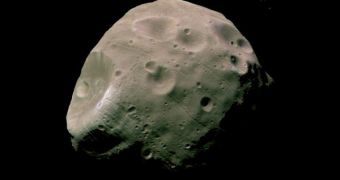Mars might not offer us too much, but its small moons may. The solar system exploration program which predicted that a base for future spaceflights would be built on our Moon is now turning towards Mars' two small moons, Phobos and Deimos. Scientists say these are the most accessible planetary bodies in our solar system, for such a use.
Though a trip to the Moon takes about three days and Phobos and Deimos are several months away, it's still easier to get a robotic mission on the Martian moons. During a conference at the agency's Ames Research Center in Moffett Field, California, scientists announced that astronauts could set foot on one of the two bodies in the next 10 years.
The main reason for the increased attention regarding Phobos and Deimos is mainly because of gravity. Gravity is the force that keeps us from floating from the planet's surface into space. On the Moon the gravity is six times smaller than that on Earth, so it's easier to leave the Moon's surface, but this still adds a lot of weight to the spacecrafts, consisting in heavy expensive fuel that needs to be carried. Mars' moons, on the other hand are tiny. Phobos is the size of Manhattan and Deimos about a third as large, meaning they have extremely low gravity, about a thousandth of that on Earth, making them ideal for landing and docking a spaceship on them.
This means that it will take a tenth of the required funding for a Martian mission to get to its moons.
Different theories about where Mars' moons came from have been published, some suggest that there are actually asteroids captured by Mars' gravity or remnants of a massive impact that blasted a single large moon. Aside from their density, size and color not much is known about these two bodies.
A robotic mission is currently on its way to launch the Phobos-Grunt in 2009 in Russia that will attempt to land a craft on Phobos, collect samples from its surface and return them safely to Earth, for further study to determine if any hydrogen or water is available for future missions.
However a manned mission could pose extreme problems, due to its low gravity Phobos could be covered with up to 4 meters of dust that can be easily mobilized and create a large cloud of dust, which could take a very long time to settle back. Radiation is another concern, a long trip to Mars can result in a 3 to 5 percent risk of death from radiation poisoning, compared to only 0.35 percent chance of dying on the International Space Station.
Some even see tourism potential in Mars' moons, their low gravity providing the possibility of long jumps, some as high as 10 meters from its surface and an incredible view of the massive red planet that would appear as much as 10 times bigger than a Full Moon on Earth.

 14 DAY TRIAL //
14 DAY TRIAL //